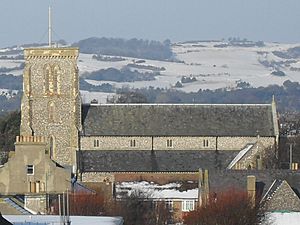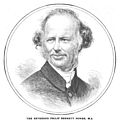Christ Church, Worthing facts for kids
Quick facts for kids Christ Church |
|
|---|---|

The church seen from the south
|
|
| 50°48′45″N 0°22′25″W / 50.81258°N 0.37359°W | |
| Location | Grafton Road, Worthing, West Sussex |
| Country | |
| Denomination | Anglican |
| Website | www.ChristChurchWorthing.org.uk/ |
| History | |
| Founded | 1840 |
| Dedicated | 1843 |
| Architecture | |
| Architect(s) | John Elliott |
| Style | Gothic Revival |
| Years built | 1812 |
| Administration | |
| Parish | Worthing, Holy Trinity with Christ Church |
| Diocese | Diocese of Chichester |
Christ Church is a historic church in the town of Worthing, England. It was officially opened in 1843 to give the town's growing population, especially poorer families, a place to worship.
Christ Church is the second oldest Church of England church in Worthing's town centre. The only one that is older is St Paul's Church, which is just a short walk away. Standing 85 feet (26 metres) tall, Christ Church is one of the most impressive buildings in Worthing, known for its walls made of a stone called flint.
Contents
History of the Church
Why Was Christ Church Built?
In the early 1800s, Worthing was getting bigger. The main parish church, St Mary's, was in Broadwater, which was a long walk for many people. Another chapel, which is now St Paul's Church, was a private chapel where people had to pay for their seats. This meant that many people with less money could not attend.
To solve this problem, the community raised money to build Christ Church between 1840 and 1843. It was created to be a church for everyone, with free seating for the poor.
Becoming an Independent Church
When it first opened, Christ Church was a chapel of ease. This means it was a smaller, extra church built to help the main parish church of St Mary's. However, in 1855, it became an official parish church in its own right, with its own community to serve.
Architecture and Design
The church was designed by the architect John Elliott in the Gothic Revival style. This style was popular in the 1800s and was inspired by the grand medieval cathedrals built hundreds of years earlier. The building's tall windows, pointed arches, and stone walls are all features of this classic style.
The Church and the Community
Christ Church has always been an important part of the local community.
Christ Church Schools
In 1860, schools for girls and infants were opened in a flint building right next to the church. This showed the church's commitment to providing education for local children.
A Place to Read and Learn
In 1859, the priest at the church, Philip Bennett Power, started a "Workmen's Reading Room" on a nearby street. This was a special place where working men could go to read books and newspapers, relax, and learn new things.
Famous People Buried at the Church
The church's burial ground is the final resting place of John Turtle Wood, an architect and archaeologist. He is most famous for discovering the lost ancient city of Ephesus in modern-day Turkey. Wood lived in Worthing and was buried at Christ Church after he died.
Music at Christ Church
The church is known for its strong tradition of choir music. It is also home to a magnificent pipe organ.
The organ has an interesting story. It was built in 1892 by a famous organ maker, J.J. Binns, for a church in Rochdale, a town in northern England. In 1967, that church was about to be demolished. To save the beautiful instrument, it was bought, rebuilt, and installed in Christ Church in 1970, where it is still played today.
Christ Church Today
Christ Church remains an active church. For many years, it worked together with other local churches, including Holy Trinity and St. Paul's.
Since 2013, the parish has been led by a new priest. After the Palm Sunday service in 2014 at Holy Trinity Church, all services for the parish have been held at Christ Church, making it a central place of worship for the community once again.
See also


